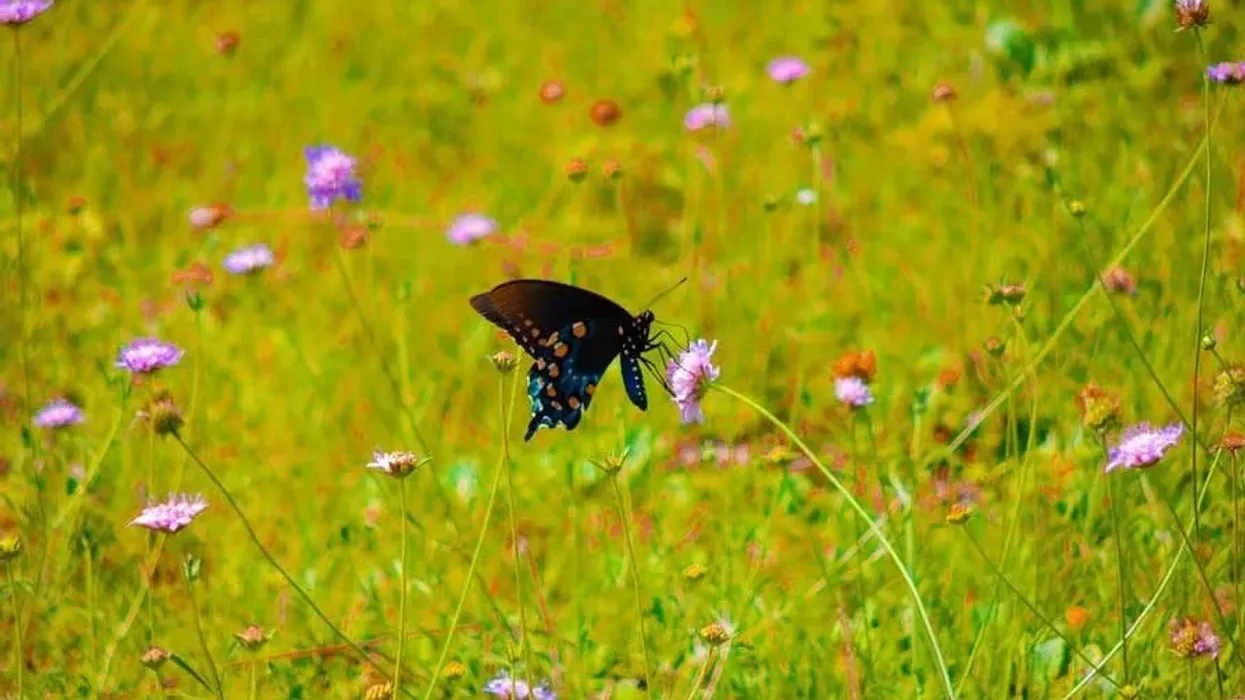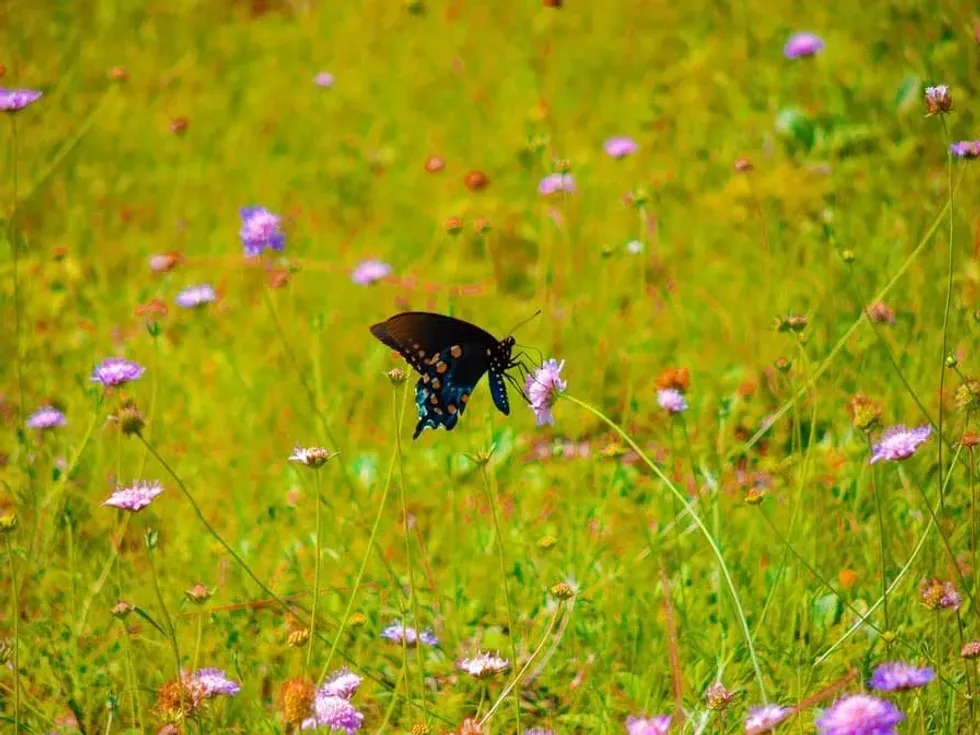The pipevine swallowtail, Battus philenor, is a magnificent butterfly that lives on the leaves of the pipevine. An adult butterfly uses a nectar-producing plant as its host.
Found in abundance in the Sonoran Desert of North America, these beauties are dark-colored with iridescent blue hindwings. They prefer warm climates where pipevines grow in abundance. They acquire their name from their pipevine host.
Battus, the genus name, is borrowed from Battus I, the founder of the Greek colony of Cyrenaica, and philenor, the species name, is derived from a Greek word that means ‘fond of husband’. They exhibit complete metamorphosis. The pipevine swallowtail life cycle includes the egg stage, larval stage, pupal stage, and adult stage.
The adults feed on nectar from many angiosperms like thistles, phlox, California buckeye, and more. Pipevine swallowtail eggs are reddish-orange and are partially covered with a firm nutritious excretion, laid down in vertical stripes.
Both the adult and caterpillar taste vile due to the Aristolochic acids ingested during the caterpillar stage. This acts as a defense mechanism to prevent potential predators from harming them. Several subspecies mimic their blue and orange coloration to evade capture by predators.
To know more about these fascinating animals, read on as we have gathered a set of interesting facts about them for you to read. You can also read up more articles on the hag moth and the wood tick.
Pipevine Swallowtail Interesting Facts
What type of animal is a pipevine swallowtail?
Also known as a blue swallowtail, they are a type of butterfly.
What class of animal does a pipevine swallowtail belong to?
Since pipevine swallowtail butterflies are insects, they belong to the class Insecta.
How many pipevine swallowtails are there in the world?
These swallowtail butterflies are not rare, even though there are reports of a decline in their local populations. According to the IUCN, there are around 1 million mature individuals present.
Where do pipevine swallowtails live?
They are widely distributed in the Northern part of North America. They can be found in New England, Florida, Nebraska, Texas, New Mexico, Arizona, Oregon, and California. There also have been inconsistent sightings in Mexico and Ontario.
The common host plant, Virginia snakeroot, is found mainly in the Eastern United States and Florida.
What is a pipevine swallowtail's habitat?
The Pipevine swallowtail butterfly that is seen abundantly in the Sonoran Desert, prefers warm, temperate environments. They are found in open habitats like woodlands, grasslands, etc.
A pipevine swallowtail butterfly uses plants belonging to the genus Aristolochia as host plants. Virginia snakeroot (Aristolochia serpentaria) is their common host plant.
Other host plants include Pipevine (Aristolochia macrophylla), Texas Dutchman's pipe (Aristolochia reticulate), Woolly Dutchman's pipevine (Aristolochia tomentosa), and California Dutchman's pipe (Aristolochia californica). They live in areas where pipevine grows in abundance, like woodlands, streamsides, grasslands, meadows, chaparral, or even backyard gardens and nurseries.
Who do pipevine swallowtails live with?
Young larvae feed together in groups. As they mature with better defense mechanisms, they become solitary. They move in search of a suitable pupation site. The males spend most of their time locating female butterflies for breeding.
How long does a pipevine swallowtail live?
The egg stage generally lasts up to 10 days. The caterpillar stage lasts for three to four weeks and it takes 10-20 days for the butterfly to come out of the chrysalis. An adult pipevine swallowtail butterfly lives for up to 14 days.
How do they reproduce?
Before mating, males absorb moisture and nutrients, particularly sodium, from mud and transfer some of the nutrients to the female during mating. They locate the females around host plants and hover above them to spread the androconial chemicals over them.
The female pipevine swallowtail butterfly lays clusters of eggs on or under the pipevine leaves or non-host plants with similar leaves, or on stems, with exposure to the sun. After the eggs hatch, the larvae feed on their own eggshells and the leaves of the host plants.
Once matured, the pipevine swallowtail larvae find convenient spots to pupate. The adult butterflies emerge during the spring.
What is their conservation status?
According to the IUCN, International Union for Conservation of Nature, these insects are listed as of Least Concern. They are given Special Concern status under the State of Michigan List. Even though the global population is under no immediate threat, the local populations have decreased due to a decrease in pipevine plants.
Pipevine Swallowtail Fun Facts
What do pipevine swallowtails look like?

In the caterpillar stage, they may grow as long as 2 inches (5 cm). The caterpillars are dark-colored with large orange projections. The chrysalis is either green or brown in color. Adult males have dark-colored wings with iridescent blue or blue-green hindwings.
Female butterflies also have the same color distribution but it is duller. These butterflies have light spots on the edges of their forewings and hindwings. There are seven bright orange spots on the undersides of their wings that warn the predators of their toxicity.
How cute are they?
A California pipevine swallowtail butterfly is gorgeous with its iridescent blue hindwings. They are really a pretty sight for the eyes of the beholder.
How do they communicate?
The bright, orange-colored spots on their hindwings act as a visual warning signal to potential predators that these butterflies are toxic. An adult male has blue iridescence on its dorsal surface that possibly acts as a visual cue to attract females for breeding. When under threat, the larvae evert their osmeterium.
How big are they?
An average butterfly has a wingspan of 1.18 in (3cm). With a wingspan of 2.75-5 in (7-13 cm), these butterflies are three or four times smaller than a Queen Alexandra's birdwing, the largest species of butterfly.
How fast do they fly?
The male butterfly is an active flyer as compared to a female butterfly. They are fast flyers but the estimate of their flying speed is not known as of now.
How much do pipevine swallowtails weigh?
Not much is known about the weight of this butterfly, but like every other butterfly, it can be considered negligible.
What are their male and female names of the species?
There are no distinct names for males and females. A butterfly of this species is commonly known as a pipevine swallowtail (Battus philenor). There is no specific name for a group of these butterflies either.
What would you call a baby pipevine swallowtail?
The baby in the larval stage is called a larva or a caterpillar whereas in the pupal stage it is called a pupa. There are no specific names for the pipevine swallowtail caterpillars or pupae.
What do they eat?
When the eggs hatch and the larvae come out, they feed on the tender leaves of the host plants. The larvae feed solely on plants of the genus Aristolochia.
Some Aristolochia species are toxic. The active Aristolochic acids are ingested to make the larva toxic so that they will be protected from their predators.
Adults feed on nectar from flowers like the pink and purple flowers of the Phlox species or ironweed of Vernonia species. They also drink from plants like buttonbush, asters, thistles (Cirsium), lupines, California buckeye, bergamot, yerba santa, lantana, petunias, teasel, etc.
Are they dangerous?
California pipevine swallowtail caterpillars ingest the toxin from their host plants and this poison remains in their body throughout their life cycle. This makes a pipevine swallowtail caterpillar poisonous.
Would they make a good pet?
If you have a backyard with California pipevine, you can raise them by increasing their mating opportunities. With a proper host plant, you can raise them throughout their life cycle, from caterpillars to adults.
Did you know...
Pipevine swallowtails spend 10-20 days in their pupal stage. In total, the metamorphosis from egg to larva to pupa to adult requires an average of around 33 days.
Pipevine seeds can be sown indoors and later transplanted to outdoor soil. You can also grow them by planting stem cuttings.
The caterpillar empties its digestive system before going into pupation. This is called a 'frass dump'.
How can you tell between male and female pipevine swallowtails?
They show sexual dimorphism in color and pattern. The dorsal surface of females is duller than that of male butterflies. Further, female butterflies have a row of white spots along the edge of their dorsal wings.
What happens if their eggs are laid on the wrong host plant?
If the eggs are laid on the wrong plant, the caterpillars should be moved to the proper pipevine swallowtail host plants immediately, failing which the caterpillars and the eggs might perish.
Here at Kidadl, we have carefully created lots of interesting family-friendly animal facts for everyone to discover! Learn more about some other arthropods including the apple snail and the mantis shrimp.
You can even occupy yourself at home by drawing one of our Pipevine Swallowtail coloring pages.










